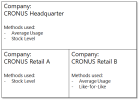

In this step the available replenishment calculation methods are explained and selected.
Available replenishment methods:
- Stock based
- Estimate based
- Sales history based
- Replacement of sold items
Stock based (Stock Level)
The stock based method uses static Reorder Points and Maximum Inventory values to identify if there is demand to replenish an item in a store or warehouse.
This is a typical approach for slow movers or to maintain a defined display stock for items.
More information can be found here: Stock Levels, Calculation Methods - Overview
Estimate based (Manual Estimate)
The estimate based method uses a sales estimate to identify if there is demand to replenish an item in a store or warehouse.
This method is often used for newly introduced items without sales history and no similar items where the sales history could be used. After the introduction period this method is usually replaced by other replenishment methods.
More information can be found here: Manual Estimate, Calculation Methods - Overview
Sales history based (Average Usage)
The sales history based method uses sales history to calculate a forecast to identify if there is demand to replenish an item in a store or warehouse.
This method is used in most scenarios and is able to calculate forecasts from sales history with consideration of seasonal patterns. Reorder Points and Maximum Inventory can be defined additionally.
More information can be found here: Average Usage, Calculation Methods - Overview
Replacement of sold items (Like for Like)
This method replaces sold items with the same quantity in the stores.
This is used for slow movers or items that are initially allocated to stores and then replenished with the same quantity as sold. High price items, like jewelery or expensive watches are typical examples.
More information can be found here: Like 4 Like, Calculation Methods - Overview
Goal
The goal of this step:
- Get an understanding on the needed replenishment methods
- Select applicable methods for retailer
Key questions / considerations
To gain information about the needed replenishment methods it is important that the retailer understands the capabilities of the different methods.
Therefore it is best practice to present and demo the different methods first and then start with questions.
Questions:
- Which of the presented replenishment methods are used currently?
- Do the methods cover the requirements?
- Are other methods in use?
- Which?
- Can those be covered with LS Replenishment methods?
Output
The output of this step is an overview of applicable replenishment methods.
Examples:
Go back to:

